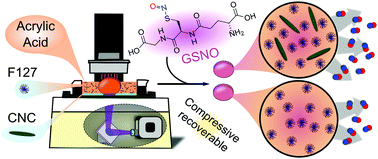3D printed nitric oxide-releasing poly(acrylic acid)/F127/cellulose nanocrystal hydrogels†
Abstract
Hydrogels have been used as matrices for the topical delivery of nitric oxide (NO) for achieving vasodilation, wound healing and analgesic actions. More recently, supramolecular hydrogels comprised of poly(acrylic acid) (PAA) and micellar Pluronic F127 (F127), prepared by thermal reaction, emerged as a suitable matrix for the incorporation of hydrophilic NO donors, such as S-nitrosoglutathione (GSNO). Herein, we describe an innovative method for the three-dimensional (3D) printing of cellulose nanocrystal (CNC)-containing and semi-interpenetrating PAA/F127 hydrogels by PAA photopolymerization via digital light processing (DLP), in the absence of organic solvents. Scanning electron microscopy showed that, differently from typical porous PAA-based hydrogels, the 3D printed PAA/F127/CNC hydrogels have dense morphology. By using transmission electron microscopy we confirmed for the first time the presence of F127 micelles in the printable resin, and their preservation after the photopolymerization process. The F127 micelles conferred compressive recoverability to the 3D printed PAA/F127/CNC hydrogels, widening their potential applications as soft biomaterials. PAA/F127/CNC hydrogels charged with GSNO are shown to release NO spontaneously upon hydration at initial rates that depend on the GSNO charge and are higher in the presence of CNC. As local NO release may exert cell proliferation action, 3D printed PAA/F127/CNC/GSNO hydrogels may serve as a versatile soft biomaterial for local NO delivery in regenerative medicine and other biomedical applications.



 Please wait while we load your content...
Please wait while we load your content...